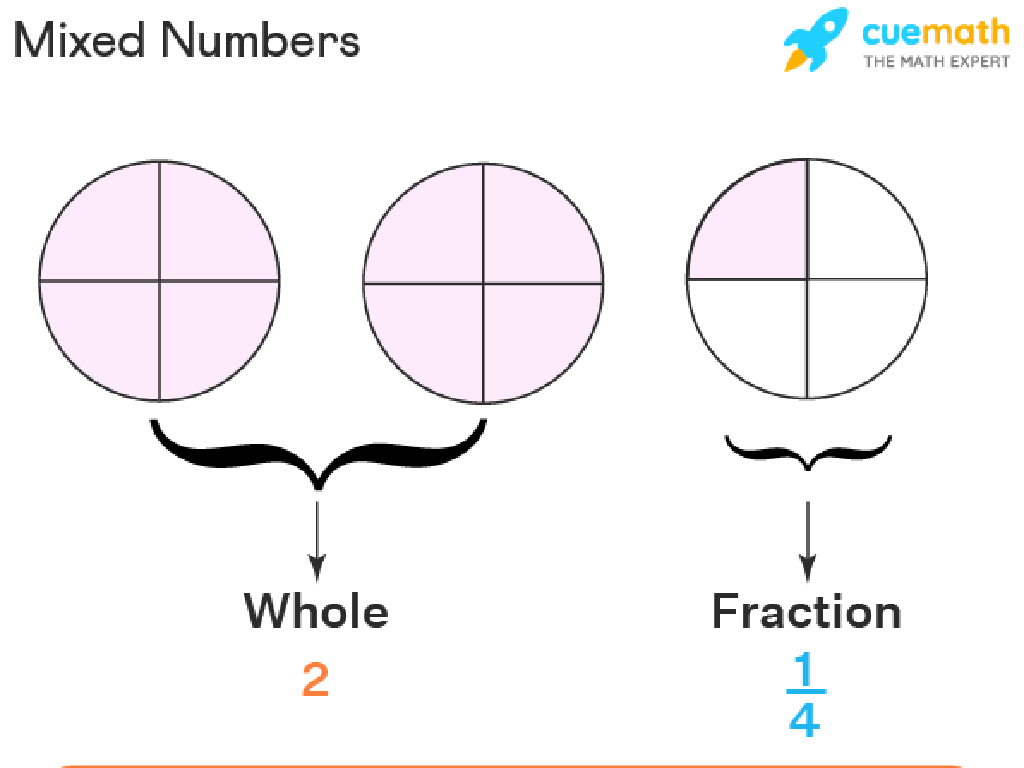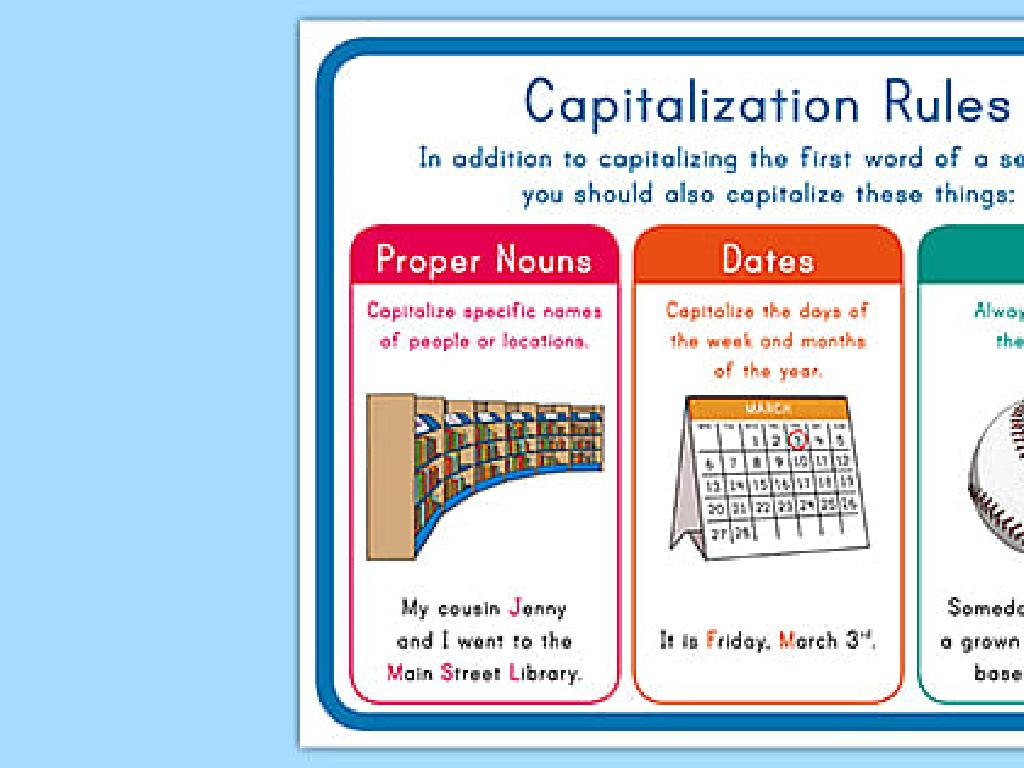Add Doubles Using Models
Subject: Math
Grade: Second grade
Topic: Addition Strategies: One Digit
Please LOG IN to download the presentation. Access is available to registered users only.
View More Content
Add Doubles Using Models
– Learn a fun way to add numbers
– ‘Add Doubles’ concept
– When two same numbers are added together, like 4 + 4
– Using models to understand doubles
– Visual aids like blocks or drawings show doubling
– Practice to become addition experts
– We’ll do activities to help you master adding doubles
|
This slide introduces the concept of ‘Add Doubles’ as a part of addition strategies for second graders. The objective is to make learning addition fun and interactive by using models such as blocks, drawings, or fingers to visually represent and understand the concept of adding two identical numbers. Emphasize the pattern that adding doubles follows and encourage students to recognize these patterns in their daily lives. Activities can include using physical objects to represent numbers, drawing out problems, or interactive games where students can practice adding doubles. The goal is for students to become comfortable and quick at recognizing and adding doubles, which is a foundational skill in mathematics.
Understanding Doubles in Addition
– Doubles: same number added together
– Like two 2s make 4 (2+2)
– Examples: 1+1, 2+2, 3+3
– 1 apple + 1 apple = 2 apples
– Doubles are easy to memorize
– Remembering doubles helps in math
– Practice with fun activities
– Use objects or drawings to learn
|
This slide introduces the concept of doubles to second-grade students, which is a fundamental addition strategy. Doubles are pairs of the same number added together, and they are an essential part of understanding addition because they are simple to learn and remember. Provide examples using small numbers to ensure clarity and relatability. Emphasize the ease of memorizing doubles as they involve repetitive patterns. Encourage students to practice with real-life objects or drawings to visualize the concept better. Activities could include using counters, drawing pairs of items, or playing memory games with double facts. The goal is to make learning doubles a fun and interactive experience.
Adding Doubles with Models
– Visualize numbers with models
– Use objects to represent numbers
– Counters, blocks, or simple drawings can be used
– Practice adding doubles
– Example: 4+4, use 4 red blocks and 4 blue blocks
– Understand addition visually
|
This slide is aimed at helping second-grade students understand the concept of adding doubles by using tangible objects or visual models. By visualizing the numbers, students can better grasp the idea of combining two sets of the same quantity. Encourage the use of everyday items like counters or blocks to represent the numbers being added. During the class activity, guide the students through a few examples, such as adding 4 red blocks to 4 blue blocks to make 8. This hands-on approach will help solidify their understanding of addition as they see the numbers come together right in front of them. Prepare to have enough materials for all students and consider pairing them up to encourage collaboration.
Adding Doubles with Counters
– Start with 2 counters
– Add 2 more counters
– Count all the counters
– Counting together helps us see the total.
– Discover 2 + 2 equals 4
– Adding the same number gets us doubles!
|
This slide is aimed at helping second-grade students understand the concept of adding doubles using physical counters. Begin by showing them two counters and then adding two more. Ask the students to count all the counters together to reinforce the concept of addition. Emphasize that when we add the same number to itself, we are adding doubles. This is a foundational skill in addition strategies for one-digit numbers. Encourage the students to use their fingers or other classroom objects to practice this concept further. The goal is for them to visualize the addition process and become comfortable with simple calculations.
Practice Time: Adding Doubles with Counters
– Try adding doubles yourself
– Use counters for 3 + 3
– Counters can be any small objects like beans or coins
– Find the sum using the counters
– Place 3 counters, then add 3 more, count all the counters together
– Share your sum with the class
|
This slide is designed for a hands-on activity where students will practice the concept of adding doubles using physical counters. Encourage the students to use items like beans, coins, or small blocks as counters. They should place three counters to represent the first ‘3’, and then add three more counters to represent the second ‘3’. After combining the counters, they count them all to find the sum. Once they have found the sum, ask them to share their answer with the class to ensure understanding and to foster a collaborative learning environment. Prepare to guide them through the process and correct any misunderstandings. Have additional examples ready for students who finish early or need extra practice.
Adding Bigger Doubles
– Adding larger doubles like 4 + 4
– Doubling means adding the same number to itself
– Use a number line for help
– A number line shows the jump from 4 to 8
– Practice leads to perfection
– The more we practice, the better we get at adding
|
This slide is aimed at teaching second-grade students how to add larger double numbers using a number line as a visual aid. Start by explaining that ‘doubles’ means adding the same number to itself. Show them how to find 4 on the number line and then count four steps forward to reach 8. Emphasize the importance of practice in mastering this skill. Encourage students to try adding other doubles using their number lines and to practice regularly to improve their addition skills. You can also introduce simple games or activities where they can practice adding doubles to reinforce the concept.
Class Activity: Doubles Bingo!
– Play Doubles Bingo game
– Cover doubles with a counter
– Use objects like beans or coins as counters
– First to cover a row wins
– Shout ‘Bingo!’ when you win
|
This interactive game helps students practice addition by identifying doubles. Prepare bingo cards with a set of numbers that are doubles (e.g., 2 and 2, 3 and 3, up to 10 and 10). Each student gets a card and a set of counters. As the teacher calls out numbers, students will cover the corresponding doubles on their cards. The first student to cover a horizontal, vertical, or diagonal row shouts ‘Bingo!’ and wins. This activity reinforces the concept of doubles and provides a fun way to practice addition. Possible variations include playing for a full card or creating patterns. Ensure that students understand the concept of doubles before starting the game.
Adding Doubles: Wrap-Up
– Congratulations on learning doubles!
– Practice with models at home
– Use objects like coins or blocks to add
– Get ready for the next strategy!
– Keep practicing and have fun!
– The more you practice, the better you’ll get!
|
This slide is meant to congratulate the students on their hard work learning to add doubles and to encourage them to continue practicing at home using tangible models such as coins, blocks, or counters. Emphasize the importance of practice in mastering this skill. Give them a heads-up about the upcoming lesson, which will introduce another addition strategy, to pique their interest. The notes should remind the teacher to praise the students for their effort, to suggest fun ways to practice at home, and to build excitement for the next lesson. Encourage the students to help each other and to find creative ways to practice their new skills.






